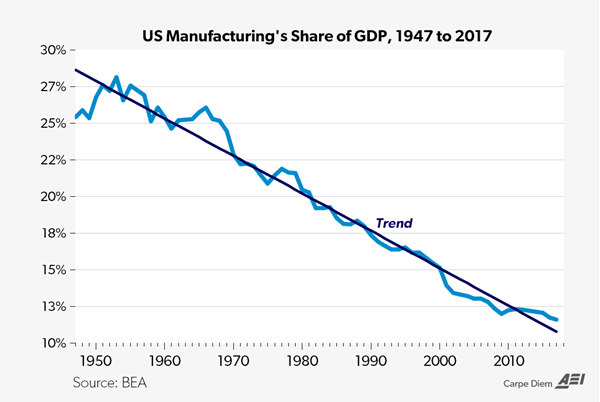The Bureau of Economic Analysis’s (BEA) report last week on GDP-by-Industry showed that real manufacturing output (value added) in the US reached an all-time record high of more than $2 trillion (in 2009 dollars) in the first quarter of this year. (See the related post “De-industrialization? Well, America’s thriving manufacturing sector just produced a record level of output in Q1.”)
[timeless]
Q2 hedge fund letters, conference, scoops etc
That was actually the third quarter in a row, starting in 2017:Q3, that US manufacturing reached record high levels, surpassing the previous record high level of US factory output established back in 2007:Q3 before America’s and other countries’ manufacturing sectors were devastated by the Great Recession.
Those effects of the recessions were so significant that it took about a decade for US manufacturing output to completely recover and reach record high production levels again. Many other countries like the UK, France, Canada, Italy, Brazil, Australia, Sweden, and Greece also experienced a long recovery period for manufacturing following the Great Recessions.
For the US, despite all of the negative news we hear about the supposed de-industrialization of America, the hollowing out of US manufacturing, and claims that we “don’t make anything here anymore,” the fact that the US set new records for manufacturing output for the last three quarters runs counter to those negative narratives of gloom and doom about American manufacturing.
And there are several other interesting long-term trends that help put America’s record-setting level of output in recent quarters in sharper perspective.
As the top chart above shows, manufacturing output as a share of US GDP has been in steady decline since the early 1950s, falling from a high of 28 percent in 1953 to a low of 11.6 percent last year. Consistent with that declining share of GDP is the fact that US manufacturing output has grown at a slower annual rate than GDP by more than one percentage point: 5.2 percent for manufacturing vs. 6.4 percent for GDP. Over the last 25 years, GDP has grown annually by 4.4 percent while factory output has grown annually by only 2.9 percent, 1.5 percentage points lower. That difference in growth rates helps explain why GDP recovered within several years of the Great Recession while it took US manufacturing much longer.
The CPI price series in the bottom chart above (as percentage changes since 1985) helps explain the downward trend of the manufacturing share of GDP by showing how much the CPI series for manufactured durable consumer goods (vehicles, furniture, appliances, tools, toys, computers, etc.) have declined in price over time compared to the CPI for All Items and the CPI for Services.
Since 1985, the CPI for Durable Goods declined by 2 percent while the overall CPI increased by 137 percent and the CPI for Services almost tripled, increasing by nearly 200 percent. On an annual basis, consumer prices have increased by 2.65 percent on average since 1985, while the CPI for services increased annually by 3.32 percent and the CPI for durable goods has fallen by 0.06 percent per year.
In real terms, the CPI for Durable Goods has fallen annually by 2.64 percent while the CPI for Services has increased 0.66 percent annually, based on the standard formula Real Rate = (1 + Nominal Rate) /(1 + Inflation Rate) – 1.
Bottom line, one of the reasons that America’s manufactured goods have become a smaller share of GDP over time (top chart) is that those goods get cheaper and cheaper over time relative to other goods, and especially relative to the cost of services (bottom chart). Therefore, for US manufacturing output to be at record high levels is even more impressive when you consider that the prices of manufactured goods have been continually and significantly falling for decades relative to other goods, services, and wages.
As stated before, US manufacturing is not in decline, but is alive and well, producing record levels of output in recent quarters despite significant price deflation for manufactured goods. No other sector of the US economy delivers greater value to American consumers than manufacturing when it comes to providing more and more output at prices that have declined annually by 2.64 percent in real inflation-adjusted terms over the last quarter-century.
Reprinted from the American Enterprise Institute.
Mark J. Perry is a scholar at the American Enterprise Institute and a professor of economics and finance at the University of Michigan’s Flint campus.
This article was originally published on FEE.org. Read the original article.
![]()


